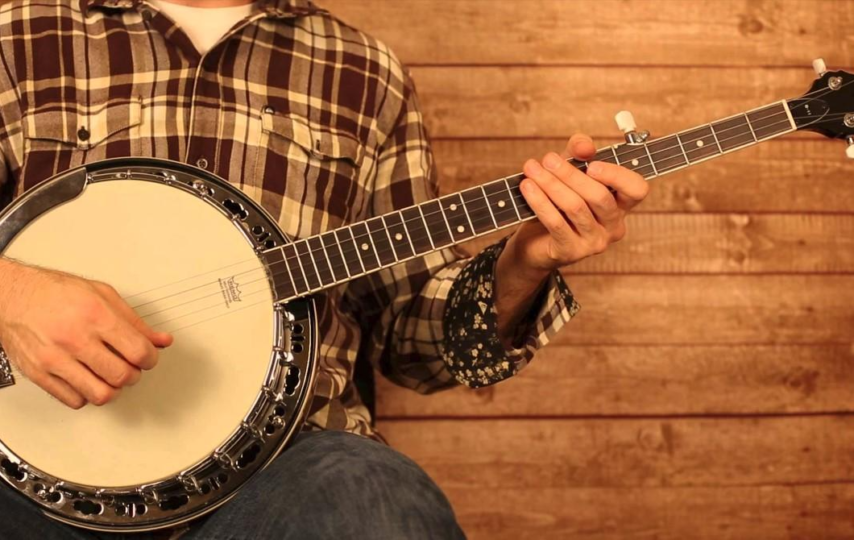The banjo is a unique-plucked instrument that is intricately linked with American folk music. Its distinctiveness lies in the drum-like body, which boasts a rounded form, in addition to an elongated fingerboard of remarkable character. The instrument frequently features in stirring performances of country music.
What is a banjo
The banjo is a type of stringed instrument that bears a resemblance to the mandolin and typically features between four and nine strings. The instrument is notable for its sonorous and vivid tonality, which conveys both warmth and sharpness. Its rise in popularity within the United States is due in part to its ability to reflect the amalgamation of African-American and European cultures, as evinced in the lively rhythms of country music.
You might be interested in the starter banjo.
History of the instrument
The history of the banjo is fraught with shadowy details. Erroneously attributed to T. Jefferson, who in 1784 provided a rather vague account of an instrument resembling the banjo but crafted from a pumpkin, the origins and dissemination of this instrument are shrouded in obscurity. However, the first comprehensive depiction of the banjo was provided by H. Sloan, an English naturalist, who, during his travels in Jamaica in 1687, observed slaves playing an extraordinary instrument and producing incendiary music with it. At that time, natives of Africa were only able to play rudimentary melodies.
With the arrival of African slaves on Caribbean islands in the 17th century, the banjo began its triumphant march toward the United States. Although the exact origins of the banjo remain a mystery, some scholars speculate that it may have originated in Africa, where similar instruments are found in countries like Zimbabwe, Cameroon, and Malawi.
In its early days in the United States, the banjo was often featured in minstrel shows with up to a dozen performers. A dance floor was set up beneath the stage, where audiences could sway to the infectious rhythms of the banjo. However, the instrument’s popularity was short-lived, as Americans began to associate it with ragamuffins, loafers, and prostitutes in comedic productions of the time. This perception led to a rapid decline in the number of musicians who played the banjo.
Subsequently, minstrel shows became popular with white people, leading to efforts to refine the instrument’s design. By the late 19th century, new musical genres such as blues, folk, jazz, bluegrass, and ragtime had emerged, and new artists began to take up the banjo, sparking renewed interest in the instrument.
Structural arrangement
The banjo presents itself as a fusion of the guitar, lute, and mandolin, featuring a simplistic yet effective design with a drum-like body and an attached steel ring to enhance tonality. The sound of the banjo is contingent upon the positioning of this ring. Strings are supported by an exterior surface, often crafted from maple or mahogany, but with the advent of modern materials, plastic has become increasingly prevalent. Some variants feature a drum fashioned from a metallic alloy, adding a new dimension to the instrument’s aesthetic. The elongated fingerboard is predominantly hewn from a singular piece of wood and adorned with metallic frets, culminating in the instrument’s distinctive headstock.

Existing Varieties
There exist numerous variations of this musical apparatus, differing in size, number of strings, and other factors. Among the most common types of banjo are:
- The Five-string. This type of banjo features a lengthy neck, with the first and fifth strings having the same thickness, yet differing in length. The fourth string is relatively thinner and produces a lower sound.
- The six-string. This version contains an additional bass string, located between the bottom and fourth strings, enabling guitarists to play the banjo.
- The Tenor. This kind boasts a shorter fingerboard and relatively smaller dimensions. In recent years, it has been utilized to perform Irish folk music.
- The Four-stringed. This version carries just four strings, following the classic G scale. The Tremolo technique is commonly employed to perform music of this type.
- The Basic. Due to its relatively large body, this kind generates a more powerful and deep sound. The tone is low.
- The Banjo mandolin. This variation features eight strings and requires the player’s utmost concentration and effort to master.
- The Banjolele. This instrument merges the features of both the ukulele and the banjo. Its appearance is akin to a miniature replica of the classic banjo. It is convenient for beginners who wish to learn to play the banjo.
How to Play the Banjo?
The art of playing the banjo is akin to that of the guitar. The tones are produced by both strumming and plucking. It’s customary for musicians to employ fingerpicks that resemble claws or plectrums to produce sound. Likewise, the use of a conventional plectrum is not unusual.
Scope
Presently, banjo playing has been incorporated into the academic domain, as it is being taught in music schools. This musical instrument is frequently utilized for playing indigenous African music. Moreover, it is employed for rendering rousing melodies in country music. During the latter half of the 20th century, banjo music gained popularity, and it became a part of orchestral performances.








